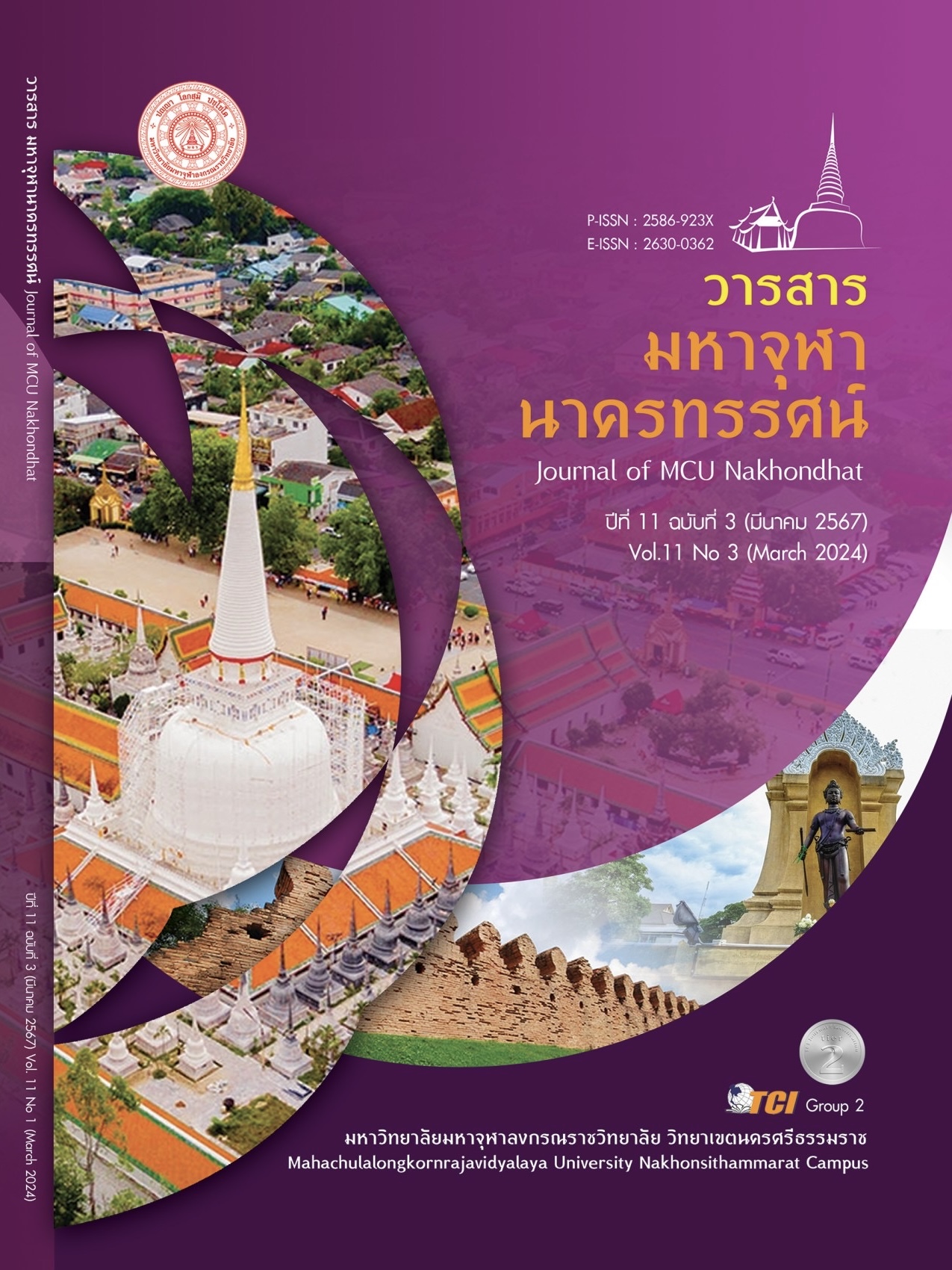SUSTAINABLE COMMUNITY WELL - BEING DEVELOPMENT THROUGH CONTEXT - BASED APPLICATION : A CASE STUDY OF BAN HUAI NUMNUAK, SUAN PHUENG DISTRICT, RATCHABURI PROVINCE
Main Article Content
Abstract
The objectives of this research paper are: 1) to study sustainable community well - being development through context-based applications; Case Study of Ban Huai Numnuak, Suan Phueng District, Ratchaburi Province, and 2) to propose guidelines for sustainable community well - being development through context - based applications. It is qualitative research that collects data using questionnaires and assessments. Group discussion issues include the following steps: Document studies, interviews with 12 leaders and community members involved in health promotion work, in-depth interviews with 10 community leaders or health promotion participants, and opinion studies from 3 experts related to community health promotion and quality of life. Data analysis with lessons learned and content analysis. Examine with triangular techniques and present descriptively. The results of the research showed that 1) sustainable community well -being development throuth context-based application consists of 5 items: 1.1) developing cooperation with local educational institutions, 1.2) supporting, promoting and facilitating community members to learn, 1.3) managing local cultural knowledge to be a body of knowledge for the community, 1.4) developing activities to promote well - being, and 1.5) supporting community organizations to carry out public activities on promoting well - being in the community. 2) guidelines for promoting sustainable community well - being development throuth context - based application. It was found that guideline 1: development of volunteer leaders working to promote community health. Guideline 2: integration of continuous health communication. Guideline 3: integrating health promotion activities in line with the community's way of life, and the 4th guideline: developing cooperation with health and quality of life promotion networks from outside the community.
Article Details

This work is licensed under a Creative Commons Attribution-NonCommercial-NoDerivatives 4.0 International License.
References
ณัชชภัทร พานิช และคณะ. (2558). ยุทธศาสตร์การจัดการระบบสุขภาพชุมชนอย่างยั่งยืน จังหวัดน่าน. วารสารสังคมศาสตร์วิชาการ, 8(ฉบับพิเศษ), 169-189.
เทศบาลตำบลสวนผึ้ง. (2561). แผนพัฒนาตำบล พ.ศ. 2561-2564. ราชบุรี: เทศบาลตำบลสวนผึ้ง จังหวัดราชบุรี.
นงเยาว อุดมวงศ์ และคณะ. (2555). การพัฒนาสุขภาวะชุมชนอย่างยั่งยืน. วารสารสาธารณสุขล้านนา, 13(1), 51-58.
ประกาศ เรื่อง ยุทธศาสตร์ชาติ. (2561). ราชกิจจานุเบกษา. เล่ม 135 ตอนที่ 82 ก. หน้า 1-61. (13 ตุลาคม 2561).
ผู้นำชุมชนคนที่ 1. (6 กันยายน 2566). การพัฒนาสุขภาวะชุมชนอย่างยั่งยืนโดยการประยุกต์ใช้บริบทเป็นฐาน: กรณีศึกษาบ้านห้วยน้ำหนัก อำเภอสวนผึ้ง จังหวัดราชบุรี. (นิภาวรรณ เจริญลักษณ์, ผู้สัมภาษณ์)
ผู้นำชุมชนคนที่ 2. (6 กันยายน 2566). การพัฒนาสุขภาวะชุมชนอย่างยั่งยืนโดยการประยุกต์ใช้บริบทเป็นฐาน: กรณีศึกษาบ้านห้วยน้ำหนัก อำเภอสวนผึ้ง จังหวัดราชบุรี. (นิภาวรรณ เจริญลักษณ์, ผู้สัมภาษณ์)
ผู้มีส่วนเกี่ยวข้องคนที่ 1. (6 กันยายน 2566). การพัฒนาสุขภาวะชุมชนอย่างยั่งยืนโดยการประยุกต์ใช้บริบทเป็นฐาน: กรณีศึกษาบ้านห้วยน้ำหนัก อำเภอสวนผึ้ง จังหวัดราชบุรี. (นิภาวรรณ เจริญลักษณ์, ผู้สัมภาษณ์)
ผู้มีส่วนเกี่ยวข้องคนที่ 2. (6 กันยายน 2566). การพัฒนาสุขภาวะชุมชนอย่างยั่งยืนโดยการประยุกต์ใช้บริบทเป็นฐาน: กรณีศึกษาบ้านห้วยน้ำหนัก อำเภอสวนผึ้ง จังหวัดราชบุรี. (นิภาวรรณ เจริญลักษณ์, ผู้สัมภาษณ์)
เรมวล นันท์ศุภวัฒน์ และคณะ. (2555). การพัฒนาระรบบสุขภาพชุมชน โดยชุมชน เพื่อชุมชน: กรณีศึกษาชุมชนตำบลไชยสถาน. พยาบาลสาร มหาวิทยาลัยเชียงใหม่, 39(2), 144-156.
เริงวิชญ์ นิลโคตร และคณะ. (2565). การพัฒนาสุขภาวะชุมชนโดยประยุกต์ใช้บริบทชุมชนเป็นฐาน: กรณีศึกษาการฟ้อนไทยทรงดำบ้านดอนทอง ตำบลดอนข่อย อำเภอสามพราน จังหวัดนครปฐม. วารสารกระแสวัฒนธรรม, 23(24), 94-110.
Hfocus. (2019). “WHO” Warning of 10 threats to global health in 2019. Retrieved December 22, 2023, from https://www.hfocus.org/content/2019/01/16776


